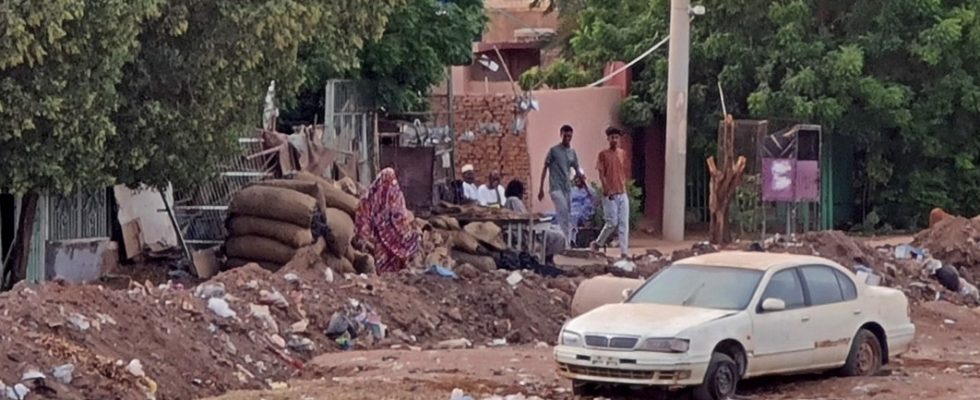Officially there is a ceasefire in Khartoum. Since Monday night. Except that Mohamed Elobaid, a young Sudanese in the city, doesn’t notice anything. For example, on Wednesday, May 24th: early in the morning he heard the salvos of the automatic rifles. street battles. In the afternoon, the situation becomes even more violent when a fighter jet descends over the area.
It is possible that fighters from militia chief Mohamed Hamdan Daglo, known as Hemeti, have the Mig-29 taken from the sky by the Luftwaffe. That’s what some say. Others believe the jet crashed because of technical defects. Neither one nor the other has been confirmed. That’s how it is in Khartoum during the war. Truth is in short supply, like so much in the battered city on the Nile.
The Air Force is under the supreme command of Army Chief Abdel Fattah al-Burhan. He is at war with his rival Hemeti, whose RSF militias have entrenched themselves at many points in the city. The generals have been destroying the capital of Sudan for six weeks, fomenting violence in Darfur. The United Nations estimates that 25 million Sudanese are dependent on aid. But many cannot be cared for without humanitarian corridors.
Both sides want to use the ceasefire to gain military advantages
Occasionally the internet is stable enough for Elobaid to send its observations via chat, along with audio messages detailing the day’s battle noise. For the fact that the generals have officially agreed on a ceasefire, there will be a loud bang this week. “We’re not experiencing a ceasefire,” says Elobaid, who organizes neighborhood aid in his neighborhood. Other Sudanese also report battles. Elobaid even says: “It is sometimes worse than usual because both sides apparently want to use these days to gain military advantages.”
Elsewhere in Khartoum, things have apparently calmed down, and nothing has changed in the conflict: both generals are counting on being able to win the fight. More likely is a strategic stalemate – devastating for civilians.
Almost a thousand fatalities are registered, the actual number is likely to be much higher. A UN official says, full of frustration, but not under his name: “The generals don’t care about people’s lives as long as they keep their power.” More than a million people have been displaced within the country and 300,000 have fled across the borders.
On May 18, a ship docked in Port Sudan on the Red Sea West Paris, belly full of sorghum. Leni Kinzli from the World Food Program (WFP) calculates that the UN can supply around one million people with 33,000 tons of millet for up to three months. But they can only help in the east at the moment. But Khartoum remains cut off. “Until the ceasefire holds, we can’t go in there.” The airport is destroyed, so you need convoys over land.
The residents of Khartoum help each other through a sophisticated neighborhood network
The residents of Khartoum must continue to help themselves. Under the most difficult circumstances, they use a sophisticated neighborhood network whose structures the democratic movement set up years ago. At that time, civil forces organized themselves to overcome the dictatorship. But the attempt at a democratic transition failed because of the calculations of those two generals who are now violently seizing power.
The civilian resistance committees, as they call themselves, try to help residents in everyday life wherever they can. Creativity and improvisation are required, as well as a lot of self-discipline. For example, they organize small markets by bringing buyers and sellers together via online platforms. They give guidance on which routes to avoid because of fights. They fetch water with trucks. “We are organized like an anthill,” says Muzdalifah al-Din, an engineer. Everyone has a fixed task for the big picture.
Al-Din and other volunteers patrol the streets unarmed at night to deter thieves. If militias or soldiers show up, retreat. Another resident says that the fighters of the RSF militia can only be avoided in a few areas, because then “everything bad” that the war brings with it often threatens. They kill, plunder. gold, money, cars. They squat, terrorize the people caught between the fronts.
A 25-year-old Sudanese woman reports in the chat that attacks on women have recently increased sharply. There are special volunteer groups for the victims of sexual violence who look after the women affected. The UN confirms the trend, with the perpetrators allegedly coming from both military camps. Or are civilians who commit crimes in the chaos.
Doctors coordinate rescue operations in Whatsapp groups
Activists have set up a warehouse with bandages, powdered milk for babies and blood donations in an abandoned apartment, says al-Din. The committees, which are spread across the neighborhoods, had also helped rescue foreign diplomats and aid workers from the city. Now they themselves urgently need support, but that won’t come as long as the fighting continues.
Doctors in particular work under the most difficult conditions. “If there are too many fighters in the area, such a committee finds it difficult to run its health stations because they harass the doctors, steal generators, etc.,” writes a resident. “Doctors Without Borders” reports that warehouses have been ransacked and vehicles, fuel and medicines stolen by armed groups. Very few hospitals can still treat patients.
Sudanese doctor Duria Rayis receives dozens of calls for help every day. She coordinates rescue operations with colleagues via Whatsapp groups. “We have to bring together surgeons, blood donations and information about the safety situation at the scene, a logistical nightmare,” says the gynecologist on the phone.
Rayis is particularly concerned about heavily pregnant women and newborns. The Medical Association estimates that around 200,000 pregnant women in the capital have no access to medical care. Clinics in particular often come under fire because militias are holed up there. And in the coming weeks, 24,000 babies will be born in Khartoum alone, the UN estimates. No sign of maternity leave.

